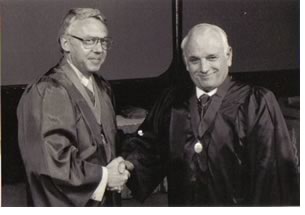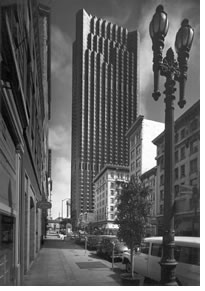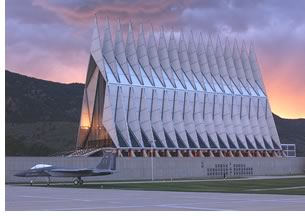

06/2005
by Joel H. “Tick” Vicars III
Architect and fire protection engineer John Leonard Fisher, FAIA, died May 13 in Rideout Memorial Hospital in his hometown of Marysville, Calif. He was 83 years old. A longstanding member of the AIA Codes and Standards Committee and the National Fire Protection Association, Fisher worked for most of his architectural career as an associate with Skidmore Owings and Merrill’s San Francisco office. As a run-of-the-mill obituary could never capture the essence of Fisher’s character and contributions to the profession, we offer the following tribute.
 John Fisher was not a man of few words; it was very easy to get him
to express his thoughts. By the nature of his education and experience,
he always had a substantial contribution for any issue you could bring
up. In listening to John, it quickly became clear that it was not so
much what he said, but how intently he was thinking about the parameters
that would provide a workable solution.
John Fisher was not a man of few words; it was very easy to get him
to express his thoughts. By the nature of his education and experience,
he always had a substantial contribution for any issue you could bring
up. In listening to John, it quickly became clear that it was not so
much what he said, but how intently he was thinking about the parameters
that would provide a workable solution.
This trait alone made him unique and so highly respected by his peers.
After serving in the U.S. Navy at the end of the Second World War through 1946, John worked in electrical engineering and quickly developed a strong awareness of mechanical systems and their importance to life safety. This awareness served him well in his 30-plus years with Skidmore Owing and Merrill, working with Gold Medal recipient Nat Owings, in life’s work that included such monumental tasks as integration of new technologies into the Federal Reserve Building in San Francisco. In his later years, his talents gave him indisputable expertise to effectively wrap up one of the largest errors-and-omissions lawsuit of the times, when he was “invited out of retirement” to review the 11 years of planning and construction of that building.
 John’s integrative way of thinking led him to become one of the first
licensed fire protection engineers. His vision made him a charter member
in the Architects, Engineers and Building Officials Section of the National
Fire Protection Association. In turn, his involvement in NFPA provided
him a powerful overview of that organization, which he shared—often
and vociferously—with his fellow practitioners.
John’s integrative way of thinking led him to become one of the first
licensed fire protection engineers. His vision made him a charter member
in the Architects, Engineers and Building Officials Section of the National
Fire Protection Association. In turn, his involvement in NFPA provided
him a powerful overview of that organization, which he shared—often
and vociferously—with his fellow practitioners.
Integration is the key
John’s integrative way of thinking also made his contributions to some
of SOM’s most noted buildings invaluable. For instance, it permitted
him to know exactly why the Sears Tower elevator (to this day) vibrates
as it passes through the 78th floor. Something about “disproven
tube theory, combined lateral forces, and patchworks . . . ” He
also devoted tremendous thought to the master planning of the U.S.
Air Force Academy in Colorado Springs. He was especially proud of
his contributions to the chapel's design team, as he had proposed and
defended the final choice for the distinctive blue-purple aerospace aluminum
and glass skin of that unique and beautiful building, which received
the AIA Twenty-five Year Award in 1996.
Many architects practice within their own hometown for their entire careers. John’s community stretched to the entire built environment. He was born in San Francisco, and many of his most recognized projects for SOM were in that city, including the Bank of America World Headquarters, the Metropolitan Life Building, the (other) John Hancock Building (now the Industrial Indemnity Building), and the Crown Zellerbach Building, one of the city’s first curtain-walled structures. Other projects in other parts of California demanded that he learn a plethora of local requirements, and so his community expanded to the State of California.
 His support to Nat Owings delivered John to the national level, where
he served for many years as a member of the AIA’s Codes and Standards
Committee, dating from his appointment in 1973. And it was at that level
that the members of the AIA owe a tremendous debt of gratitude. The way
John thought about life-safety issues, the standards-making organizations,
the model code groups, the AIA’s role in strengthening its members,
and the way architects think of themselves were issues with which John
filled even his last days on earth, long after he had received his Fellowship
in 1983 and even after he “retired” from practicing architecture.
His support to Nat Owings delivered John to the national level, where
he served for many years as a member of the AIA’s Codes and Standards
Committee, dating from his appointment in 1973. And it was at that level
that the members of the AIA owe a tremendous debt of gratitude. The way
John thought about life-safety issues, the standards-making organizations,
the model code groups, the AIA’s role in strengthening its members,
and the way architects think of themselves were issues with which John
filled even his last days on earth, long after he had received his Fellowship
in 1983 and even after he “retired” from practicing architecture.
Always thinking
Last September I visited John at his home with his daughters and wife
of more than 50 years, Eva, who was in poor health. That afternoon
he was thinking of the many ways he could make Eva’s days special.
He was thinking of the repercussions of California’s recent
adoption of the NFPA’s new building code. He was thinking of
the mistakes his community of Marysville had made in not reinforcing
its old rice-paddy dikes, which had collapsed and caused hundreds of
cattle to drown in the flooding. He was thinking of how the two of
us could take a week to trace the Lewis & Clark Trail through Montana
and Idaho.
John just never stopped thinking about the built environment. And he never stopped thinking about the people he cared about. As I was leaving, I asked him for some guidance for my next 10 years. Without looking up, he said, “Tick, read a lot, stay active in your community, and talk with as many people as you can.”
So, there’s just one more thing: On behalf of the architecture community, I feel I must simply say, “Thank you, John. Thank you for thinking of us.”
Copyright 2005 The American Institute of Architects.
All rights reserved. Home Page ![]()
![]()
 |
||
John Fisher is survived by Eva, his wife of 52 years, and three daughters and two sons. The Fisher family requests that donations in John’s memory be made to Shriners Hospital, P.O. Box 21-4477, Sacramento, CA 95821. Joel “Tick” Vicars is an architect from southwestern Virginia, who directed the national AIA Codes and Standards Committee in the 1980s and now lives in Boise and works in Emmett, Idaho.
|
||